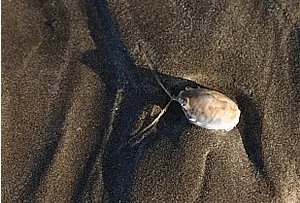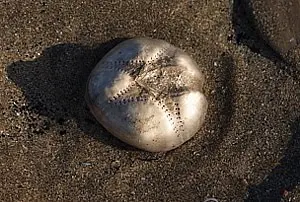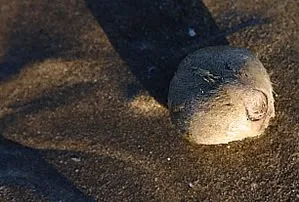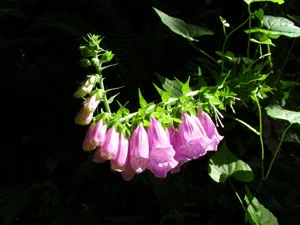 Wind Chill Factor Westward Ho! -3rd January 2010.
Wind Chill Factor Westward Ho! -3rd January 2010.  All photos,articles copyright P. M. Adams North Devon Focus all rights reserved.
All photos,articles copyright P. M. Adams North Devon Focus all rights reserved.  It’s freezing cold but dry and sunny so perfect for a New Year stroll on the beach at Westward Ho! At the slipway we move aside for three horse riders taking advantage of the two mile stretch of firm sand and a rare opportunity to enjoy an uninterrupted gallop. The tide is a long way out thus exposing the hulk of one, of two, rarely visible Westward Ho! wrecks. Took some photos from different angles but my hands were so numb with the cold that I couldn’t actually feel the shutter button. As I was testing a new lens, I decided to take close up shots and made my way up the beach, head down searching for interesting sand formations, sea creatures, seaweed, shells and pebbles on the lower and middle shoreline moving towards the strandline and the Pebble Ridge. Even after recent storms this is a wonderful clean beach worthy of its’ Blue Flag status. We spent about an hour beachcombing and saw plenty of razor shells, periwinkles, whelks, mussels, tiny crabs and other crustaceans, kelp, wrack, sea urchins and lots of sea potatoes. Sea pototoes or heart-urchins are, weirdly, heart-shaped and covered in fur! They are normally hidden beneath the sand and only appear on the surface when washed up after stormy weather. Suddenly the noise of the wind and crashing surf was completely drowned out by the loud thundering hooves of the horses as they galloped back down the beach from Sandymere. Only three horses, but the sound carried some distance so one can only imagine the sound of the 500 horses in the Charge of the Light Brigade. The beach is still practically deserted, a few dog walkers, one lone hardy surfer and one kite buggy circling far off beside the sand dunes.
It’s freezing cold but dry and sunny so perfect for a New Year stroll on the beach at Westward Ho! At the slipway we move aside for three horse riders taking advantage of the two mile stretch of firm sand and a rare opportunity to enjoy an uninterrupted gallop. The tide is a long way out thus exposing the hulk of one, of two, rarely visible Westward Ho! wrecks. Took some photos from different angles but my hands were so numb with the cold that I couldn’t actually feel the shutter button. As I was testing a new lens, I decided to take close up shots and made my way up the beach, head down searching for interesting sand formations, sea creatures, seaweed, shells and pebbles on the lower and middle shoreline moving towards the strandline and the Pebble Ridge. Even after recent storms this is a wonderful clean beach worthy of its’ Blue Flag status. We spent about an hour beachcombing and saw plenty of razor shells, periwinkles, whelks, mussels, tiny crabs and other crustaceans, kelp, wrack, sea urchins and lots of sea potatoes. Sea pototoes or heart-urchins are, weirdly, heart-shaped and covered in fur! They are normally hidden beneath the sand and only appear on the surface when washed up after stormy weather. Suddenly the noise of the wind and crashing surf was completely drowned out by the loud thundering hooves of the horses as they galloped back down the beach from Sandymere. Only three horses, but the sound carried some distance so one can only imagine the sound of the 500 horses in the Charge of the Light Brigade. The beach is still practically deserted, a few dog walkers, one lone hardy surfer and one kite buggy circling far off beside the sand dunes. 
 Northam Burrows Country Park is beyond the Pebble Ridge at Westward Ho! on the Atlantic Heritage Coast. The Northam Burrows Country Park, at the mouth of the Taw Torridge Estuary, is a designated site of scientific interest and forms part of the United Nations Biosphere Reserve. If you can identify any of the shorelife in these pictures please let us know.
Northam Burrows Country Park is beyond the Pebble Ridge at Westward Ho! on the Atlantic Heritage Coast. The Northam Burrows Country Park, at the mouth of the Taw Torridge Estuary, is a designated site of scientific interest and forms part of the United Nations Biosphere Reserve. If you can identify any of the shorelife in these pictures please let us know.

 24th June 2009
24th June 2009
Midsummer and the swifts are soaring above the lane by the Coach and Horses.The vegetation either side of the Peppercombe trail is now at its fullest. At the start of the track the hedge is at least seven foot high with black bryony, flowering dog roses and honeysuckle climbing upwards through the leafy hedgerow. The verges now crammed with massive hogweed, thistle, red campion, foxgloves and sorrel spiking up from low lying buttercups and clover. The leaves on the ancient trees are now fully formed creating a canopy over the valley. Compared to Springtime the trail down is now in shade except for the occasional sunlit patches where wonky foxgloves bend over instead of upwards probing for the light. The massive fungus, pictured, was high up in an ivy clad tree. By the pink cottage rhododendrons are in flower but the stream by the bridge has all but dried up. Further on down past the old stables, the huge bank by the wooden bungalow is now full of ferns. This area was carpeted by primroses in March and April followed by bluebells in May. In the past donkeys and ponies have grazed in the upper and lower meadows and this year’s summer visitors, the Belted Galloway cattle, have settled into Peppercombe Meadows, under the coast path. Pathways and glades are opened up as a result of them grazing allowing a much greater range of grasses and wild flowers to emerge in Spring and Summer. The dung left behind benefits  beetles and other insects which in turn provides a source of food for birds. The cattle were chosen because they are extremely hardy and have a “generally docile nature”. While I was there they didn’t lift their heads up and continued grazing quietly so keep to the path and they won’t even notice you. Read the sign, keep dogs on the lead and shut the gate. Ferns seem to be in abundance at the further end by the steps but the rest as usual full of wild flowers and grasses. In earlier years this site had a large number of big old gorse bushes which were home to many spiders. I arrived down at the beach in glorious sunshine and was greeted by a couple of blokes sitting on the cobbles who, on seeing the camera, pointed out a seal bobbing off-shore. The black blob didn
beetles and other insects which in turn provides a source of food for birds. The cattle were chosen because they are extremely hardy and have a “generally docile nature”. While I was there they didn’t lift their heads up and continued grazing quietly so keep to the path and they won’t even notice you. Read the sign, keep dogs on the lead and shut the gate. Ferns seem to be in abundance at the further end by the steps but the rest as usual full of wild flowers and grasses. In earlier years this site had a large number of big old gorse bushes which were home to many spiders. I arrived down at the beach in glorious sunshine and was greeted by a couple of blokes sitting on the cobbles who, on seeing the camera, pointed out a seal bobbing off-shore. The black blob didn ’t hang around. The only other life forms were three gulls and the elderly couple I had spoken to earlier who were on their way to Portledge the hard way. After a very slow descent down the steep cliff path they now began to traverse the cobbles, explorer style, with walking poles. In contrast a more nimble pair scampered down with nets aloft ready for shrimping. Clear blue sky and still blue sea so there was excellent light over Clovelly and Hartland Point to the left and Portledge meadows above the red cliffs to the right. Beyond Portledge the South West Coastal Path leads to Abbotsham Cliffs and Westward Ho!. Below the path, the lower cliff is clad in heather with new shoots so this will make for a colourful August. I have been taken photographs of Peppercombe Beach, Peppercombe Valley and its wild flowers for many years so please visit my web site to see more Peppercombe Seasons. There is a good hike along the South West Coast Path from Peppercombe to Bucks Mills. The most colourful time for this in May when the woods are full of bluebells. Photos copyright Pat Adams
’t hang around. The only other life forms were three gulls and the elderly couple I had spoken to earlier who were on their way to Portledge the hard way. After a very slow descent down the steep cliff path they now began to traverse the cobbles, explorer style, with walking poles. In contrast a more nimble pair scampered down with nets aloft ready for shrimping. Clear blue sky and still blue sea so there was excellent light over Clovelly and Hartland Point to the left and Portledge meadows above the red cliffs to the right. Beyond Portledge the South West Coastal Path leads to Abbotsham Cliffs and Westward Ho!. Below the path, the lower cliff is clad in heather with new shoots so this will make for a colourful August. I have been taken photographs of Peppercombe Beach, Peppercombe Valley and its wild flowers for many years so please visit my web site to see more Peppercombe Seasons. There is a good hike along the South West Coast Path from Peppercombe to Bucks Mills. The most colourful time for this in May when the woods are full of bluebells. Photos copyright Pat Adams
 Wind Chill Factor Westward Ho! -3rd January 2010.
Wind Chill Factor Westward Ho! -3rd January 2010.  All photos,articles copyright P. M. Adams North Devon Focus all rights reserved.
All photos,articles copyright P. M. Adams North Devon Focus all rights reserved.  It’s freezing cold but dry and sunny so perfect for a New Year stroll on the beach at Westward Ho! At the slipway we move aside for three horse riders taking advantage of the two mile stretch of firm sand and a rare opportunity to enjoy an uninterrupted gallop. The tide is a long way out thus exposing the hulk of one, of two, rarely visible Westward Ho! wrecks. Took some photos from different angles but my hands were so numb with the cold that I couldn’t actually feel the shutter button. As I was testing a new lens, I decided to take close up shots and made my way up the beach, head down searching for interesting sand formations, sea creatures, seaweed, shells and pebbles on the lower and middle shoreline moving towards the strandline and the Pebble Ridge. Even after recent storms this is a wonderful clean beach worthy of its’ Blue Flag status. We spent about an hour beachcombing and saw plenty of razor shells, periwinkles, whelks, mussels, tiny crabs and other crustaceans, kelp, wrack, sea urchins and lots of sea potatoes. Sea pototoes or heart-urchins are, weirdly, heart-shaped and covered in fur! They are normally hidden beneath the sand and only appear on the surface when washed up after stormy weather. Suddenly the noise of the wind and crashing surf was completely drowned out by the loud thundering hooves of the horses as they galloped back down the beach from Sandymere. Only three horses, but the sound carried some distance so one can only imagine the sound of the 500 horses in the Charge of the Light Brigade. The beach is still practically deserted, a few dog walkers, one lone hardy surfer and one kite buggy circling far off beside the sand dunes.
It’s freezing cold but dry and sunny so perfect for a New Year stroll on the beach at Westward Ho! At the slipway we move aside for three horse riders taking advantage of the two mile stretch of firm sand and a rare opportunity to enjoy an uninterrupted gallop. The tide is a long way out thus exposing the hulk of one, of two, rarely visible Westward Ho! wrecks. Took some photos from different angles but my hands were so numb with the cold that I couldn’t actually feel the shutter button. As I was testing a new lens, I decided to take close up shots and made my way up the beach, head down searching for interesting sand formations, sea creatures, seaweed, shells and pebbles on the lower and middle shoreline moving towards the strandline and the Pebble Ridge. Even after recent storms this is a wonderful clean beach worthy of its’ Blue Flag status. We spent about an hour beachcombing and saw plenty of razor shells, periwinkles, whelks, mussels, tiny crabs and other crustaceans, kelp, wrack, sea urchins and lots of sea potatoes. Sea pototoes or heart-urchins are, weirdly, heart-shaped and covered in fur! They are normally hidden beneath the sand and only appear on the surface when washed up after stormy weather. Suddenly the noise of the wind and crashing surf was completely drowned out by the loud thundering hooves of the horses as they galloped back down the beach from Sandymere. Only three horses, but the sound carried some distance so one can only imagine the sound of the 500 horses in the Charge of the Light Brigade. The beach is still practically deserted, a few dog walkers, one lone hardy surfer and one kite buggy circling far off beside the sand dunes. 
 Northam Burrows Country Park is beyond the Pebble Ridge at Westward Ho! on the Atlantic Heritage Coast. The Northam Burrows Country Park, at the mouth of the Taw Torridge Estuary, is a designated site of scientific interest and forms part of the United Nations Biosphere Reserve. If you can identify any of the shorelife in these pictures please let us know.
Northam Burrows Country Park is beyond the Pebble Ridge at Westward Ho! on the Atlantic Heritage Coast. The Northam Burrows Country Park, at the mouth of the Taw Torridge Estuary, is a designated site of scientific interest and forms part of the United Nations Biosphere Reserve. If you can identify any of the shorelife in these pictures please let us know.








